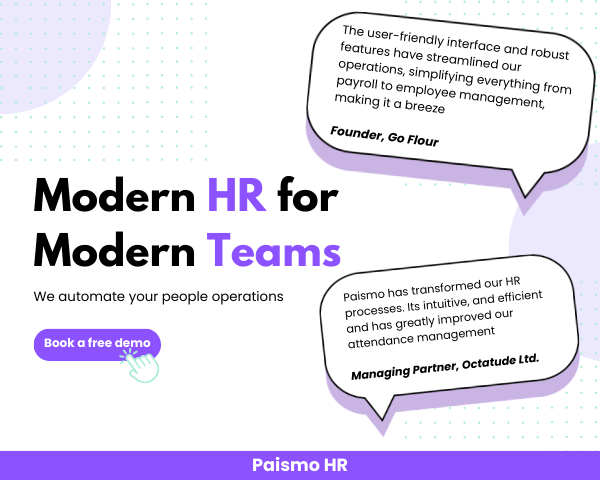Highlights
- Exempt employees get fixed salaries and don’t receive overtime pay for extra hours worked.
- Non-exempt workers are hourly employees and must be paid overtime beyond 40 hours a week.
- Clear policies and proper onboarding help employees understand their classification and workplace rights.
- Using HR tools makes managing compliance, time tracking, and role classifications easier.
Managing employee classifications doesn’t have to be confusing. Knowing the difference between exempt vs non exempt employees helps you stay compliant, avoid payroll mistakes, and improve team satisfaction. Exempt employees are not eligible for overtime, while non-exempt workers must be paid for extra hours. If you misclassify roles, it can lead to legal issues or unhappy staff. That’s why many companies now use employee management software to simplify this process.
In this guide, you’ll learn how to identify each category quickly and manage your workforce more confidently, without the guesswork or manual tracking.
What Are Exempt Employees?
Exempt employees are not entitled to overtime pay under labor laws. They usually receive a fixed salary and work in executive, professional, or administrative roles. To qualify, they must meet the salary threshold and pass the duties test the Department of Labor set. Unlike hourly workers, exempt employees don’t get paid for extra hours.
In the non-exempt vs exempt employees debate, this group often enjoys more flexibility and benefits. Many companies now rely on HR software to help classify roles correctly and avoid compliance mistakes.
Examples of Exempt Employees
To make things clearer, here are some real examples of jobs that usually fall under the exempt category. These roles often involve higher-level tasks, decision-making, and leadership responsibilities.
- Business executives often lead teams, make big decisions, and shape company goals.
- Accountants in senior roles handle complex financial tasks and use independent judgment.
- Marketing professionals working in strategy often guide campaigns and influence business direction.
- Managers supervise staff, approve schedules, and take part in hiring or firing decisions.
- Executive assistants who support top-level leaders often handle tasks that directly affect operations.
To ensure a good fit, companies often run a background check before confirming these positions.
Requirements for Exempt Employees
To classify someone as exempt, a few basic conditions must be met. Let’s break them down one by one.
- Salary Payment
Exempt employees must be paid a fixed salary, not hourly wages. Their paycheck remains the same each pay period, regardless of hours worked. This ensures consistency and meets FLSA salary basis rules.
- Total Earnings
To qualify as exempt, employees must meet the salary threshold set by the FLSA. For example, in recent years, this has been around $684 per week. If earnings fall below this, the role is usually non-exempt.
- Job Duties
Lastly, the employee’s work must involve professional or decision-making tasks. These roles often require special skills or experience, which is common in on-site positions or when managed through an employer of record.
What Does Non Exempt Employee Mean?
A non-exempt employee is someone who qualifies for overtime pay under labor laws. These workers are paid by the hour and receive extra pay, usually time and a half, when working more than 40 hours a week.
Unlike salaried employees in the exempt vs non-exempt employees group, non-exempt staff are protected by both overtime rules and minimum wage laws. They usually work in positions with set schedules and require accurate time tracking.
Examples of Nonexempt Employees
To better understand who qualifies as a nonexempt employee, here are a few common examples. These roles are usually paid hourly and must receive overtime pay when working more than 40 hours a week.
- Electricians often work on projects with changing hours. Since they are paid by the hour, they must receive overtime for extra work.
- Construction or maintenance workers usually earn hourly wages and qualify for overtime after 40 hours a week.
- Cashiers, especially in retail, are paid hourly and receive overtime when they work long shifts.
- Clerical or secretarial staff handle office tasks and must be paid extra when their hours go over the weekly limit.
- Food servers in restaurants or cafes also earn hourly pay and qualify for overtime during busy or extended shifts.
For any small business, knowing which roles are nonexempt is essential. When building an employee transition plan, correct classification helps ensure fair wages, legal compliance, and smooth team changes.
Requirements for Nonexempt Employees
To stay compliant with labor laws, employers must follow a few key rules when managing nonexempt workers. Here are the main ones to keep in mind.
- Minimum Wage
Minimum wage rules require nonexempt employees to earn at least the federal minimum rate. However, since some states set higher wages, employers should always review local laws to stay compliant.
- Overtime Pay
If a nonexempt employee works more than 40 hours in a week, they must receive overtime pay. This is typically 1.5 times their regular hourly rate. The rule applies even if extra hours are on weekends or holidays.
- Accurate Time Tracking
Accurate time tracking is essential for ensuring fair pay and legal compliance. Moreover, clear records of hours worked help reduce payroll errors. With a reliable system in place, employees receive correct and timely payments.
Difference Between Exempt vs Non Exempt Employees?
Knowing the difference between exempt vs non exempt employees helps ensure fair classification. The table below clearly guides proper employee classification and legal compliance.
| Category | Exempt Employees | Non-Exempt Employees |
| Pay Type | Receive a fixed salary regardless of hours worked | Paid by the hour based on actual time worked |
| Overtime | Not entitled to overtime pay | Eligible for overtime after 40 hours per week |
| Job Duties | Focus on strategic, administrative, or professional tasks | Handle routine, task-based, or manual duties |
| Work Schedule | Manage their own time with flexible scheduling | Follow assigned shifts with recorded hours |
| Legal Coverage | Excluded from overtime and minimum wage laws | Protected under federal wage and hour regulations |
| Role Type | Common in executive, managerial, or specialized positions | Found in clerical, technical, or operational roles |
| Classification | Requires careful review to meet exemption criteria | Must be classified accurately to meet labor law requirements |
How to Implement Effective Exempt vs Non Exempt Employees Status Practices?
To manage employee status the right way, companies need clear steps that everyone can follow. Below are easy and practical actions that help keep the process smooth and compliant.
- Keep Communication Open With Managers
Keep communication open with managers by encouraging them to inform HR about any updates in job roles or salaries. This helps maintain accurate employee classification and ensures everyone receives the correct pay without delays.
- Understand And Follow Labor Laws
Understand and follow labor laws by staying updated on federal and state regulations. Sometimes a roles may not fit into exempt or non-exempt categories. In such cases, it’s best to consult HR or legal experts to avoid compliance issues.
- Make Policies Easy To Find And Read
To ensure clarity from the start, make sure your employee handbook clearly explains exempt vs non-exempt roles. Additionally, include simple rules about overtime, breaks, and remote work. This way, employees can easily understand their rights and daily expectations.
- Get Written Confirmation During Onboarding
Get written confirmation during onboarding so employees clearly understand their job status and key policies. Having them sign the paperwork early avoids future confusion and protects both sides.
By using these practices, companies can manage employee classification with more confidence. It also builds trust and keeps daily operations running smoothly.
Summary
Understanding the difference between exempt vs non exempt employees helps businesses stay compliant and avoid payroll errors. Clearly defining each role reduces legal risks and builds a more transparent work environment. When employees know how they are classified, it creates trust and boosts confidence across your team. As your company grows, applying these status practices consistently supports smoother operations and smarter workforce planning.
FAQ
What Is Exempt vs Non Exempt Employee?
An exempt employee earns a fixed salary and does not receive overtime pay. A non-exempt employee is paid hourly and must be paid overtime for extra hours worked. These classifications follow labor law rules.
Become a part of the Paismo community
Paismo is an HR software that can help simplify your HR operations. In today's dynamic economic environment, efficient HR and automated payroll management are no longer a luxury but a necessity. Paismo is a comprehensive solution that transforms traditional HR complexes into streamlined and automated workflows. Paismo and its paired biometric device integration can be used for your business to mark employee attendance and record their timesheets accurately.
Paismo simplifies your tasks with its core HRMS, timesheets, and attendance management, as well as biometric attendance, payroll automation, and leave management system.
Take the first step toward modernizing your HR and payroll processes and explore what Paismo can do for you. Book a demo with our sales team.









